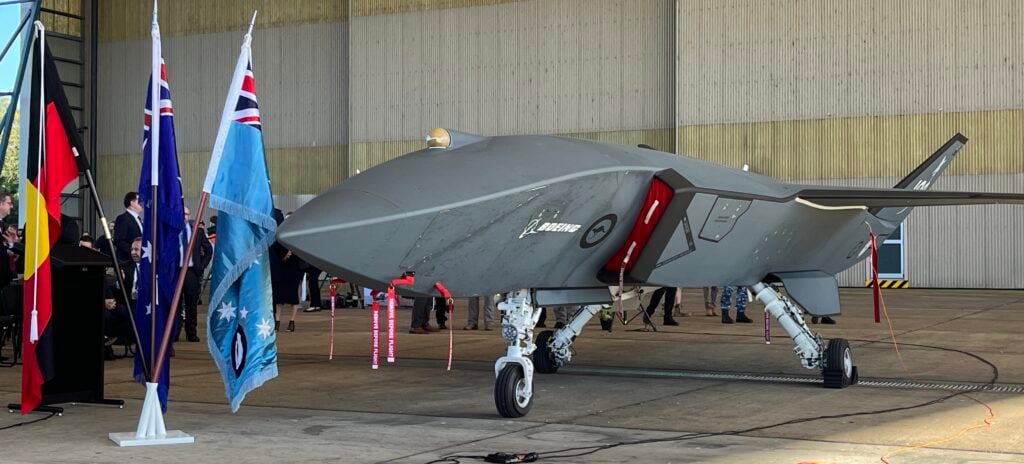
The Australian Loyal Wingman drone is named Ghost Bat at RAAF Base Amberley. Credit Colin Clark
RAAF AIR BASE AMBERLEY: Australia, clearly thrilled by its apparent success in designing and building a new aircraft for the first time in 50 years, is eagerly aiming for substantial export sales of the Loyal Wingman drone system.
Peter Dutton, Australia’s defense minister, made a point of showing up at the naming ceremony for the Loyal Wingman, now known as the “Ghost Bat” after an Australian critter.
”This is, you know, potentially a billion dollar export for us. And there are many hundreds, if not thousands of jobs that come with the maintenance, the upgrades that go with those aircraft,” Dutton said here of the aircraft, which went through design and development in just three years. “All of that is a very significant undertaking. And it’s not just that the manufacturing now and the export potential but it’s to get it to this point.”
So far, Boeing and the RAAF have built six MQ-28 Ghost Bats, as it’s formally designated. While some have flown, the fleet is now undergoing extensive ground testing.
“Selecting the Ghost Bat, an Australian native mammal known for teaming together in a pack to detect and hunt, reflects the unique characteristics of the aircraft’s sensors and Intelligence, Surveillance and Reconnaissance abilities, and is a fitting name for this pioneering capability,” Glen Ferguson, who heads the program for Boeing, said at the Monday morning ceremony here.
With the Australian federal budget due next Tuesday, Breaking Defense asked Dutton how many Ghost Bats the government planned to fund. He did not give a direct answer, saying only that ”There is a great utility in having scale and being able to launch an aircraft like this, because it complements what we’re doing with our fast jets and our other assets on water on land.”
That would seem to indicate Australia may well be looking at producing dozens of the Ghost Bat in the next five years, especially if they want to maximize scale as they begin to make foreign sales.
One of the intriguing things about the aircraft is that the nose is essentially a separate assembly. According to Ferguson, Boeing is telling potential customers that they have two choices: have Boeing do the sensor package, or take the nose and insert your own sensor setup. (Ferguson would not identify any potential customers.)
RELATED: Australia launches defense self-reliance campaign: ‘In your own backyard’
The aircraft uses an open architecture to facilitate integration. While the aircraft can work with sensors and systems from a wide range of countries, it also incorporates components from a number of countries, so Boeing will have to comply with relevant export controls when it’s approached by a customer, Ferguson said.
Boeing is building a factory to turn out large numbers of the aircraft in the town of Toowoomba’s Welcamp Airport, the first of its kind outside the United States. The factory is not far from Air base Amberley, where the first six planes have been built. It’s worth noting that the state of Queensland, where Toowoomba is located, is a crucial battleground for the upcoming elections here; Dutton’s claims of “thousands” of jobs need to be taken in that context.
One of the intriguing things about the drone program is that it is moving at such speed — from nothing to flight and ground testing in three years — that it’s not even clear if there will be any conventional acquisition milestones, such as full production. Instead, after years and years of discussions in Washington and elsewhere about spiral acquisition and upgrades as they path forward for faster acquisition, the Loyal Wingman program appears to actually be doing it effectively. Ferguson said they expect to do unsubstantial upgrades every two years “to get to a next generation of airframes.”
Overall, the Boeing executive said the Australian government’s commitment to the Ghost Bat program “has been unparalleled.” On such a fast-moving program, with the attendant risks, that may be a requirement for it to succeed.






















